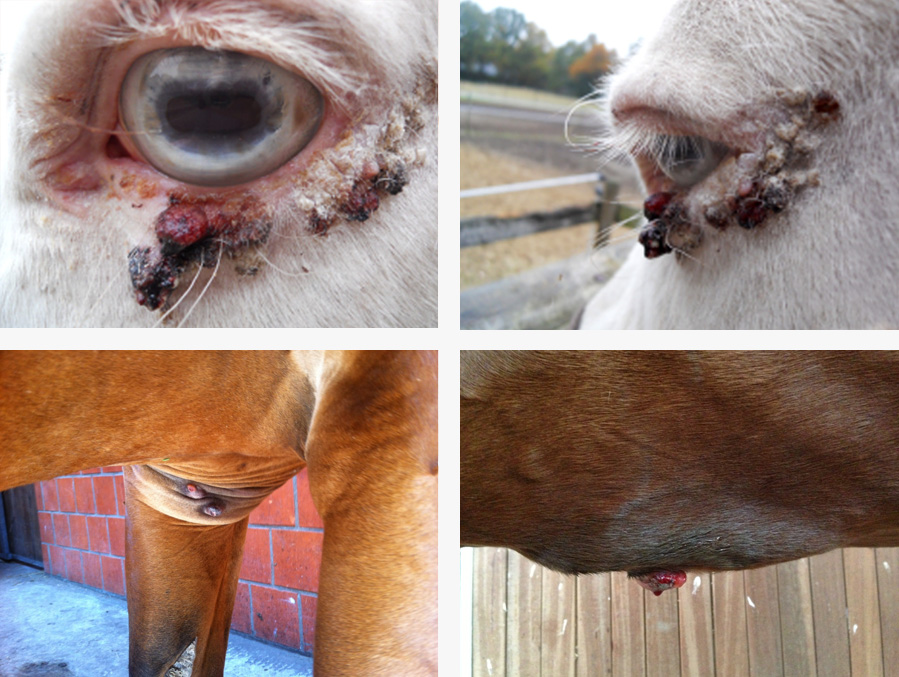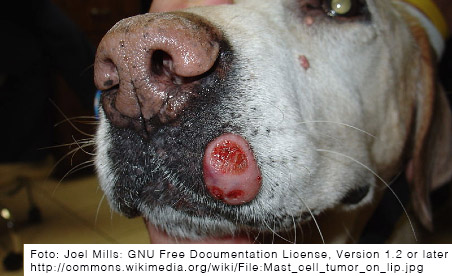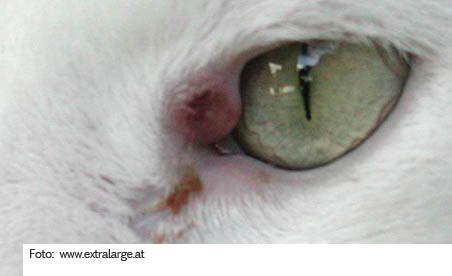Diseases and the Immune System in Animals
The immune system evolved over millions of years and our immune cells have learned to successfully fight diseases with incredibly fascinating strategies. Immunizations, for example, protect like a magic shield, making the body unassailable. Killer cells defend us like a secret army. We currently know nowhere near everything about this highly complex defense system and are learning more each day.
Here we describe some diseases and conditions that have been successfully treated in innovative immunological scientific studies. We know that many more diseases exist and will regularly be reporting new findings here. But please don’t forget that these new findings on the immune system have a direct and tremendous relevance not just for animals but also for humans.
Equine Sarcoids
Equine sarcoids are the most commonly occurring skin tumours in horses. They are virus-induced pathological skin lesions that occur only externally and do not tend to metastasize to internal organs. After surgery, however, the tumour often recurs and large-area excision will mutilate the animal, e.g. loss of an eye.
Sarcoids are most common on areas of the body with little hair and thin skin such as the inside of the thighs, the face, and around the eyes and ears. Over 40% of all horses carry this virus. There is no breed, gender or color predilection. Equine sarcoid is more than a cosmetic problem. If the location is unfavorable, it spreads, or it is improperly treated, the horse may become unusable or even require euthanasia.
Causes
The cause of equine sarcoid is the bovine papilloma virus (BPV Type 1 and 2). The tiniest wounds in the skin can be the site of entry of the virus. Usually the skin tumours are found in animals between the ages of three and seven. The DNA of the virus can be identified in nearly 100% of all tumours. Parts of the virus genome can also be identified in the blood of horses. Evidently, an inadequate immune defense is responsible for onset of the disease. Also genetic predispositions or a combination of these factors may be involved.

Tumour Types
There are six different classifications according to Pascoe and Knottenbelt:
- Type 1: Occult sarcoid: The affected skin is usually hairless and slightly raised and sometimes there is slightly nodular and hyperkeratotic growth.
- Type 2: Verrucose sarcoid: It appears as a wart-like growth with hyperkeratosis.
- Type 3: Nodular sarcoid: It presents as subcutaneous nodules of varying size and can be pedunculated. The skin above it is usually hairless but intact.
- Type 4: Fibroblastic sarcoid: It has a cauliflower-like appearance with ulcerated surface and serous exudates. It may also have a pedicle (stalk).
- Type 5: Mixed sarcoid: It looks like a mix of the verrucose, nodular and fibroblastic sarcoids.
- Type 6: Malevolent sarcoid: It often appears after multiple traumas and can infiltrate the lymph system. Then nodules can be seen along the lymph channels.
The mild types named above first can transform to the serious types after removal, but also spontaneously.
Treatment
Many treatment options are available for therapy of equine sarcoid, but they are usually too ineffective or costly. Surgical excision poses the risk that not all parts of the tumour are removed, which would result in recurrence. Also used is chemotherapy or immunization with Bacillus Calmette-Guérin, a live vaccine against tuberculosis. Often different forms of therapy are combined. With a cure rate of over 80% to 90%, radiotherapy – either as brachytherapy or teletherapy – offers the best chances for complete recovery. Brachytherapy has been available in German since 2009, but is used very rarely because of the high costs. Besides harming the animal, the economic damage caused by the papilloma virus is considerable. The use, sale and breeding of the horse are threatened and there is a great need for effective, safe, easy to use and affordable therapies.
Outlook
4 Animals AlsterScience GmbH works to directly influence the defense against the pathogen and is currently developing therapies that improve the immune function of animals and support their immunological defense.
Strengthening specifically of the immune system is an innovative approach. The body’s own proteins ensure that disease-causing pathogens can be repelled without use of antibiotics or virostatics. Especially in veterinary medicine, where infections can spread quickly in groups, there is a tremendous need to improve resistance to pathogens in order to avoid follow-up therapies (e.g., antibiotics, operations, radiation treatments). Infections, tumours, stress and demands for high performance are regularly associated with disturbances in the function of the immune system; viruses can multiply successfully and impair immune system function by infection. This results in a vicious circle with worsening of the course of the disease and long-term complications.
4 Animals AlsterScience GmbH is currently working closely with recognized experts to accomplish in effective steps the development of highly effective, well-tolerated products for pets and food-producing animals that strengthen the immune system.
in dogs and cats
Mast Cells
Mast cells belong to the haematopoietic system and are derived from stem cells in the bone marrow. They are found throughout the body of an animal and help it fight inflammation and allergies. Mast cells produce a number of biologically active substances like serotonin, histamine and enzymes. Although these chemicals are vital to body function, they can be extremely harmful when produced in chronic excess. When mast cells of the haematopoietic system multiply abnormally, a tumour may result.
Mast Cell Tumours, Incidence and Causes
Tumours of the mast cells are one of the most common skin neoplasias in dogs. Development of mast cell tumours in internal organs tends to be rare. Tumours develop most often on the extremities, trunk and head. Occasionally, they are also found in the mucous membrane of the oral cavity and the conjunctiva. The tumour is less common in cats than in dogs and occurs in cats mainly on the head. Animals of every breed, age and sex can be affected. However, there appears to be a genetic component, making some breeds more susceptible than others. The cause for the tumour is unknown. Possibly a weakened or defective immune system, viruses, or genetic predispositions are factors.

Appearance, Course of the disease
The appearance of mast cell tumours varies so widely that basically any growth on or under the skin could be a mast cell tumour. They present as nodules, raised patches, lumps and extensive, infiltrative and ulcerated forms. Soft, non-irritated subcutaneous tumours cannot be distinguished from benign fatty tumours. Therefore the only way to diagnose them is by biopsy. It can be difficult not only to diagnose these tumours but also to predict their course. They can be relatively harmless as well as aggressively malignant.
Substances stored in the tumours can cause a number of changes locally and systemically. The symptoms are extremely variable and strongly dependent on the location and tumour grade. They range from loss of appetite, vomiting and diarrhea to bleeding, abdominal pain, delayed wound healing and gastrointestinal ulcers.
Tumour Grade
Mast cell tumours can be classified according to the degree of differentiation of the cells. The most common classification system is based on the Patnaik grading criteria of 1984.
Tumour grade 1 (well differentiated)
• Distinct cell boundaries
• Round to oval, regular cell nuclei
• Hardly any mitotic cells
• Numerous granules, large and well stained
Tumour grade 2 (moderately differentiated)
• Indistinct cell boundaries
• Few mitotic cells
• Granules reduced in size, number and staining
Tumour grade 3 (poorly differentiated)
• Cell boundaries hardly discernible
• Cell size and nucleus-cytoplasm ratio highly variable
• Many mitotic cells
• Few small, poorly stained granules
Treatment
Because mast cell tumours are unpredictable, they should be considered potentially malignant. The treatment method of choice is therefore the earliest possible surgical removal of the tumour. Adjuvant chemotherapy and radiation therapy may also be used, especially if the location of the tumour makes complete excision impossible or uncertain. On some parts of the body the oncological 2-3 cm rule (i.e. removal of a large area of healthy tissue around the tumour) cannot be satisfied. Examples are tumours on the leg or paw because this would result in loss of nerves, vessels and tendons, making it necessary to consider amputation.
The latest scientific findings show that immune therapies, especially if applied locally, can support therapy effectively and are well tolerated.
Outlook
4 Animals AlsterScience GmbH develops therapies that improve the immune function of animals with tumours and support immunological defense.
Specifically strengthening the immune system for fighting malignant tumours is an innovative approach. The body’s own proteins ensure that cancer cells cannot spread. There is a great need to supplement or replace surgical procedures in order to save limbs and preserve the quality of life of animals.
4 Animals AlsterScience GmbH is currently working closely with renowned experts to accomplish in effective steps the development of highly effective, well-tolerated products for pets and food-producing animals that successfully strengthen the immune system.cheffektiver, gut verträglicher Produkte zur erfolgreichen Immunstärkung für Haustiere und lebensmittelerzeugende Tiere in zielführenden Schritten umzusetzen.
Right now we are working on new, innovative products that we will be reporting on soon.


